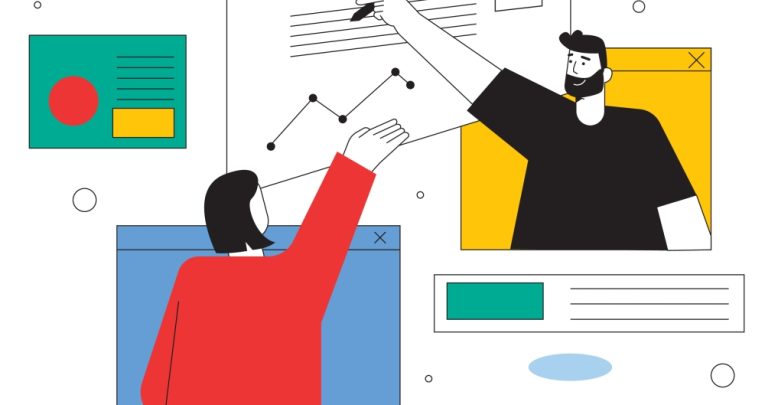Blended learning – Teaching through lockdown could usher in a post-COVID edtech revolution

Alex More considers how the profound disruptions endured by schools have helped pave the way for more positive attitudes around staff development and educational technology…

- by Alex More

I may be alone in saying it, but from my perspective, this has been perhaps the most creative time in education I’ve ever encountered in the 19 years I’ve been teaching.
When I’m in school, most days are busy and I don’t get much time to stop. More recently, however, on the two days I’ve been at home I’ve had valuable time between lessons, where normally I’d be pulled from pillar to post.
In just one recent seven-day period, for example, I spoke to people in Dubai, Finland, New York and Australia on different timescales. Connecting with educators across the world to discuss the problems we’re all having to manage has been fascinating.
How are they doing in their settings? What technologies are they using? What ‘hacks’ have they found that are useful, and which we might be able to share with the schools in our trust? It’s been a really interesting time for collaboration and creativity. There’s currently a lot of content out there, thanks to many educators using their own extra time in creative ways. Not all of it is great, but some of what’s available is genuinely ground-breaking.
EdTech improvements
At the same time, some of the technology we’ve seen emerge to help with online learning has been phenomenal. An example we’ve recently used ourselves is a platform called Mosaic 3D, which allows users to render a virtual 3D model on a screen and interact with it.
For example, a biology teacher can ‘dissect’ a heart, zooming in on the aorta and pulmonary vein. The effect is really ‘in your face’ – it’s a powerful technology that’s had a hugely positive impact on students’ engagement with the content I’ve been teaching.
An online service that’s perhaps not on many people’s radar is WaterBear. This is a streaming video platform that’s free for educators, and which hosts a large selection of feature-length and short films focusing on the natural world, all shot really well and in high definition.
Google have meanwhile launched a new service called Earth Studio, which is essentially Google Earth taken to the next level. I teach a lot of sport, and when I was recently covering the Japan 2021 Olympics, I was able to show my class the process of zooming in from the stratosphere, all the way down to where the events will be hosted from a street-level view.
Remote learning
When it comes to making use of these and other ideas across the whole school, however, there can often be some resistance. The way in which teaching has been structured for the past decade has, I believe, encouraged teachers to become quite habitual in their practice. They have their classes and their classrooms, and that’s just the way things are.
It’s sometimes difficult to get staff to look beyond that, because they’re comfortable with the day-to-day practice of what they’re already doing. We’ve been able to introduce some new ideas at Shaftesbury School that have been fairly effective over the years – one of which was to organise trios of working groups.
We have 60 teaching staff in our school, and around 15 TAs. We placed every member of staff in a group of three, being very careful as to which groups each individual was assigned to. We would often start with a lead expert – someone with a real passion for an idea like growth mindset or knowledge organisers. We then partnered them with someone a little less enthusiastic about those notions – but in the context of a trio, having added a third person to the group, there are fewer places to hide.
The idea is for every member of staff to be exposed to new ideas, whether they agree with them or not. For us, it’s intended mainly as a nurturing environment for new ideas, rather than an INSET activity where staff are explicitly instructed in the workings of a new initiative.
Another practice we’ve adopted is to film our teachers teaching, either via Teams or in physical classes. We’ll then produce six-minute snippets of these lessons for distribution across the trust’s Sharepoint site, which teachers can dip into at the direction of their line managers.
For example, I may have someone who, in my view, isn’t questioning very well in their lessons – it may be that I can signpost them towards a certain video. That can serve as a small nudge for them to rediscover their mojo, because teaching is hard. Teachers have targets to meet and lots of content to get through, so it’s natural for them to sometimes silo themselves away from their colleagues.
Covid 19 schools
Once the dust settles, post-pandemic, I think educational technology will be one of biggest beneficiaries. Teachers have now had to embrace it, and been given little choice in the matter. As a result, they’re naturally going to have more confidence in using educational technology in a better, more creative way than they may have done in the past.
I also think we can expect to see a bit more awareness of how difficult teaching is as a profession, and greater awareness around how mental health can affect staff and students. Recovering from what we’ve been through is going to be an involved process that staff will be at the forefront of. Our students, as actors in the learning, will have to be resilient and bounce back themselves.
I do, however, believe that education will change in some positive ways as a result of this – with more flexibility perhaps being built into the system, and technology ultimately driving forward that positive change.
Alex More is assistant headteacher at Shaftesbury School; follow him at @Alex_MoreEd.
Computing curriculum
Atif Mahmood, founder and CEO of the lesson planning platform Teacherly, shares his thoughts on how schools can foster a culture of collaboration
What can be some of the main obstacles preventing schools from building effective cultures of collaboration? Schools will rarely collaborate with other schools, even in the same chain or group, because of a lack of leaders who truly understand how to embrace a more collaborative approach to teaching and learning. Time is a constraint, and the need to constantly deliver lessons, deliver results and climb league tables is one of the reasons why there isn’t a greater culture of collaboration. The English curriculum itself is a barrier to developing a culture of collaboration
What are some of the most novel or innovative strategies you’ve seen teachers and schools use to address the challenges of COVID? We’ve seen may adopting social tools to promote collaboration, through which teachers can share ideas and have space to support one another. Teachers have gone to websites like Udemy and Coursera to learn more about remote teaching or remote working, while headteachers have taken advantage of platforms like Teacherly and WhatsApp to encourage staff to support each other both online and offline.
What do you see as the most encouraging, and most damaging, impacts of the pandemic across the teaching profession? The most damaging long-term effect of the pandemic on the teaching profession may be the large numbers of teachers choosing to leave the profession because they want more of a work-life balance. Similarly, some students, particularly those with additional learning needs, may be worse off following the pandemic, because remote learning and teaching platforms aren’t necessarily geared towards catering to those needs.
In terms of more encouraging effects, we may start to see schools developing more of a hybrid/blended learning model in future, and doing more to embrace flexible working and learning. There’s an opportunity now to reinvent the way we assess pupils and change legacy systems that have been in place for many years.
For more information, visit teacherly.io.











